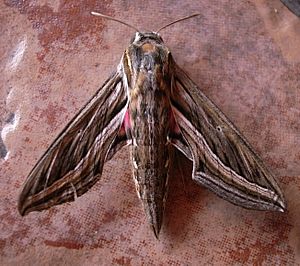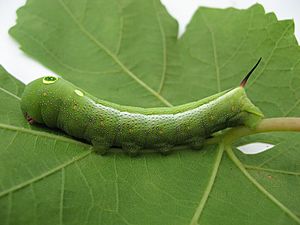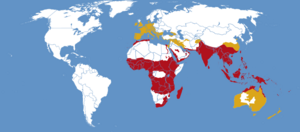Vine hawk-moth facts for kids
Quick facts for kids Vine hawk-moth |
|
|---|---|
 |
|
 |
|
| Scientific classification | |
| Synonyms | |
|
The vine hawk-moth, also known as the silver-striped hawk-moth, is a type of moth. Its scientific name is Hippotion celerio. This moth belongs to a family called Sphingidae, which are often known as hawk-moths. The famous scientist Carl Linnaeus first described this moth in 1758.
Contents
Where the Vine Hawk-Moth Lives
You can find the vine hawk-moth in many parts of the world. It lives in Africa and central and southern Asia. This includes countries like India and Sri Lanka.
These moths also travel a lot. They are often seen as migrants in southern Europe and Australia. This means they fly long distances to different places.
What the Vine Hawk-Moth Looks Like
The vine hawk-moth is a medium-sized moth. Its front wings are usually about 28–35 millimetres (1.1–1.4 in) long. That's about the length of a small paperclip!
Colors and Patterns
The body and front wings of an adult moth are usually green and a yellowish-brown color. They have shiny silver-white dots and lines. A clear silver band runs across the front wing.
The back wings are red near the bottom corner. This red color fades to pink over the rest of the wing. There is a black bar and black lines (veins) crossing the back wing.
Moths of this species can look a bit different from each other.
- Some might have a very pale yellowish-brown color.
- Others might have wings that look more red or deep brown.
- In some moths, the black markings cover almost the whole wing.
- A few might not have any silver markings at all.
- In rare cases, the silver stripe on the front wing can be yellowish instead of silver.
Similar Moths
There are a couple of other moths that look a lot like the vine hawk-moth.
- Hippotion osiris is a larger moth. It does not have the black lines on its back wings that the vine hawk-moth has.
- Hippotion aporodes might just be a very dark version of the vine hawk-moth. In this form, the silver stripe on the front wing is missing. Also, its back wings are mostly brownish.
Life Cycle: The Larva (Caterpillar)
The young stage of the moth is called a larva, or caterpillar. These caterpillars can be green, yellowish-green, or even brown.
They have a broken dark line down their back. They also have a creamy white line along their sides, from the fifth body part to their "horn." The head of the caterpillar is round and usually a dull green. The horn on its back is usually long and straight.
The caterpillar has two large "eyespots" on its body. One is yellow and green on the third body part, and a smaller one is on the fourth body part. These spots can make the caterpillar look like a snake, which helps scare away predators!
What Larvae Eat
Vine hawk-moth caterpillars like to eat the leaves of certain plants. Their favorite foods include:
- The grape vine
- Plants from the Cissus family
- Impatiens plants, also known as busy Lizzies
- The Arum lily
See also
 In Spanish: Esfinge de banda plateada para niños
In Spanish: Esfinge de banda plateada para niños






